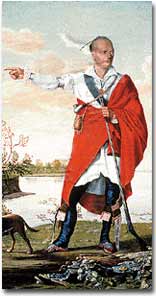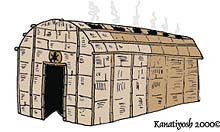1d. The Iroquois Tribes

The Masssachusetts Mohawk Trail began as a Native American footpath used for trade, hunting, and social calling by five tribes, including the Pocumtuck and the Mohawk.
The Iroquois people have inhabited the areas of Ontario and upstate New York for well over 4,000 years.
Technically speaking, "Iroquois" refers to a language rather than a particular tribe. In fact, the Iroquois consisted of five tribes prior to European colonization. Their society serves as an outstanding example of political and military organization, complex lifestyle, and an elevated role of women.

Mohawk Indian chief Joseph Brant served as a spokesman for his people, a Christian missionary of the Anglican church, and a British military officer during the Revolutionary War.
Governance and War
Until the 1500s, the five tribes of the Iroquois devoted much energy toward fighting and killing each other. According to oral tradition, it was about this time that they came to their senses and united into a powerful confederation.
The five tribes designed quite an elaborate political system. This included a bicameral (two-house) legislature, much like the British Parliament and modern U.S. Congress. The representatives, or sachems, from the Seneca and Mohawk tribes met in one house and those of the Oneida and Cayuga met in the other. The Onondaga sachems broke ties and had the power to veto decisions made by the others. There was an unwritten constitution that described these proceedings at least as early as 1590. Such a complex political arrangement was unknown in Europe at that time.
|
Roots have spread out from the Tree of the Great Peace, one to the north, one to the east, one to the south and one to the west. The name of these roots is The Great White Roots and their nature is Peace and Strength... The soil of the earth from one end of the land to the other is the property of the people who inhabit it. By birthright the Ongwehonweh (original beings) are the owners of the soil which they own and occupy and none other may hold it. The same law has been held from the oldest times. The Great Creator has made us of the one blood and of the same soil he made us and as only different tongues constitute different nations he established different hunting grounds and territories and made boundary lines between them... Whenever a foreign nation is conquered or has by their own will accepted the Great Peace their own system of internal government may continue, but they must cease all warfare against other nations... The women of every clan of the Five Nations shall have a Council Fire ever burning in readiness for a council of the clan. When in their opinion it seems necessary for the interest of the people they shall hold a council and their decisions and recommendations shall be introduced before the Council of the Lords by the War Chief for its consideration. | ||
Although the tribes began to work together, they surely did not renounce war. They fought and captured other native tribes as well as wave after wave of European immigrants who presented themselves. They fought the early French and British settlers. During the French and Indian War they remained officially neutral, but would join either side to exploit an advantage. Both sides courted Iroquois support during the Revolution. As a result, there was a split in the Confederacy for the first time in over 200 years. Iroquois fought Iroquois once more.
Iroquois Society

The Iroquoi Tribes, also known as the Haudenosuanee, are known for many things. But they are best known for their longhouses. Each longhouse was home to many members of a Haudenosuanee family.
The longhouse was the center of Iroquois life. Archaeologists have unearthed longhouse remains that extend more than the length of a football field.
Agriculture was the main source of food. In Iroquois society, women held a special role. Believed to be linked to the earth's power to create life, women determined how the food would be distributed — a considerable power in a farming society.
Women were also responsible for selecting the sachems for the Confederacy. Iroquois society was matrilineal; when a marriage transpired, the family moved into the longhouse of the mother, and family lineage was traced from her.
The Iroquois society proved to be the most persistent military threat the European settlers would face. Although conquest and treaty forced them to cede much of their land, their legacy lingers. Some historians even attribute some aspects of the structure of our own Constitution to Iroquois ideas. In fact, one of America's greatest admirers of the Iroquois was none other than Benjamin Franklin.








